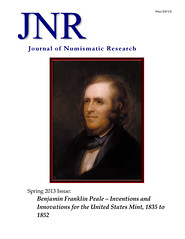
PREV ARTICLE
NEXT ARTICLE
FULL ISSUE
PREV FULL ISSUE
BOOK REVIEW: JOURNAL OF NUMISMATIC RESEARCH, SPRING 2013
With permission, republished below is Len Augsburger's review of the latest issue of Roger Burdette's Journal of Numismatic Research from the April 2013 issue of the Liberty Seated Collectors Club's electronic newsletter, The E-Gobrecht.
-Editor
Peale's first assignment at the Mint was to survey the European Mints for technological advances, and for this he was dispatched on a two-year journey to the Old World. U.S. Mint Director Samuel Moore was particularly interested in the process of separating gold and silver, and in improving the assay of silver deposits. Peale delivered on this and much more. Burdette does a deep dive into a dozen areas and discusses how Peale introduced any number of improvements into the Mint during this period. The combination of Moore and Peale was powerful. Moore had spearheaded the construction of the Second Mint "for which the necessary appropriations were obtained chiefly by his own influence and exertions, and which was begun and completed under his immediate superintendence," according to his obituary. Moving from the "old and contracted" building on Seventh Street in Philadelphia to the "spacious and elegant marble edifice" at Chestnut and Juniper Streets was not just a move ahead for the Mint, but a visceral construction demonstrating American capability to the rest of the world. Philadelphians were proud, and images of the second Mint exploded in the literature, whereas images of the first have only recently been clawed out of the archives. Moore had done his part, and now it was up to Peale to bring real technology into a real building. Peale returned to the Mint in 1835, and met more than a little resistance, including from our own Christian Gobrecht, who is said to have been displeased with a method of reproducing dies introduced by Peale. Peale stood his ground, and is most notably credited by Burdette with the introduction of the toggle press. The collector mindshare surrounding Peale is more typically focused on the steam-powered press, which Peale did indeed introduce, but Burdette finds the toggle technology more remarkable. To be sure, the introduction of steam power simply wasn't applied directly to an existing screw press. A new type of press was needed to properly harness the power of steam, and Burdette sets the record straight. Peale went on to make advances in all operations of the Mint - as Roger explains it, he reworked the entire process from refining, to rolling, to cutting, to striking and even counting and weighing. For the first time, this entire story can be found in one place. I expected Roger to clean out the National Archives (I was aware that Peale had written a lengthy report on his European tour, but had never gotten around to calling for the document) but he does this and much more. Peripheral resources, especially related to technology and manufacturing, are integrated in Burdette's analysis to full effect. I have to admit, when I first heard about this work, I was hoping it would include the semi-lurid details about Peale's termination at the Mint in 1854. A report at the time had Peale building whoopee cushions in order to embarrass lady visitors. Be warned, this is a serious book and readers searching for such hijinx are referred elsewhere, most notably to the Richard Sears McCulloh pamphlet, the proceedings of the late director of the mint, in relation to the official misconduct of Franklin Peale, Esq., chief coiner, and other abuses in the mint (1853). In the meantime, those interested in the coining technology surrounding Liberty Seated coinage will have trouble doing any better than this book. I grade this book an MS69, withholding the MS70 grade only because I have just received an advance copy of Burdette's latest book From Mine to Mint, which is even better and will be reviewed in a future column. This work is available exclusively from Wizard Coin Supply and may be ordered at www.wizardcoinsupply.com/journal-of-numismatic-research/.
Roger informs me that the printed copies are not available just yet, and as of Sunday afternoon the Wizard site did not yet have the new issue posted for sale electronically. But keep an eye for their appearance at the Wizard site.
-Editor
Wayne Homren, Editor The Numismatic Bibliomania Society is a non-profit organization promoting numismatic literature. See our web site at coinbooks.org. To submit items for publication in The E-Sylum, write to the Editor at this address: whomren@gmail.com To subscribe go to: https://my.binhost.com/lists/listinfo/esylum All Rights Reserved. NBS Home Page Contact the NBS webmaster 
|
